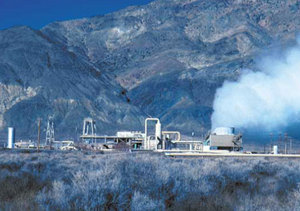The discovery could reveal some secrets about how hot fluids deep in the crust control earthquakes as well as lead to new geothermal energy sources.

|
| ©BLM |
| Scientists detected excess helium-3 at the Dixie Valley geothermal plant in central Nevada, shown here. |
A first-ever helium map of the Basin and Range Province -- a geologic region which runs from western Utah westward to eastern California and includes all of Nevada -- shows the relative amounts of helium-3 over helium-4 steadily increasing east to west. The new helium map is being published in the Nov. 30 issue of the journal Science.
Helium-3 comes from the mantle, beneath the crust, whereas helium-4 is produced within the crust itself.
The survey which led to the helium map was inspired by scientists trying to figure out why there was excess helium-3 at the Dixie Valley geothermal plant in central Nevada.
"I was perplexed by that," said geologist and lead author of the Science report, B. Mack Kennedy of Lawrence Berkeley National Laboratory. "We set out to see if Dixie Valley was an anomaly. So we did a survey to see the background signal."
The clear helium-3 trend across the Basin and Range was a surprise, Kennedy told Discovery News. But it just might fit with what's known about the way the crust behaves across the same stretch of Earth.
In Utah and eastern Nevada the Basin and Range is dominated by vertical faults which are not thought to penetrate to the mantle -- so there's less helium-3 getting though there, Kennedy surmised.
Further west, however, the north-south running faults shift more and more sideways -- north-south -- which creates shearing stresses in the crust. That shearing could penetrate to the mantle, creating conduits for hot fluids to move upwards even without a volcanic eruption.
A good example of Helium-3 getting up through a sideways-moving fault, says Kennedy, is the San Andreas Fault. Previous work had established excessive helium-3 there, he said.
The helium-3 in Nevada and along the San Andreas Fault could be also suggesting something important about how hot fluids from the mantle affect sideways-moving faults, and perhaps influence earthquakes.
"The role of deep fluid movement in changing stresses in the upper crust and triggering earthquakes remains unclear," reports geologist David Hilton of the Scripps Institution of Oceanography in La Jolla, Calif., "yet these two very different tectonic regimes share a common feature:" They both have excess helium-3 without any signs of volcanic activity.
The helium-3 map could also be pointing the way to good places to drill for clean, green, geothermal energy, Kennedy said. Right now there are very few clues, other than obvious geysers and hot springs, to guide geologists to geothermal resources. Helium-3 could be used as a sort of geothermal dowsing rod.



Reader Comments
to our Newsletter